A Novel NIR Fluorescent Probe for Highly Selective Detection of Nitroreductase and Hypoxic-Tumor-Cell Imaging
Abstract
:1. Introduction
2. Results and Discussion
3. Conclusions
Supplementary Materials
Author Contributions
Funding
Institutional Review Board Statement
Informed Consent Statement
Data Availability Statement
Conflicts of Interest
References
- de Oliveira, I.M.; Henriques, J.A.P.; Bonatto, D. In silico identificationg of a new group of specific bacterial and fungal nitroreductases-like proteins. Biochem. Biophys. Res. Commun. 2007, 355, 919–925. [Google Scholar] [CrossRef]
- Hecht, H.J.; Erdmann, H.; Park, H.J.; Sprinzl, M.; Schmid, R.D. Crystal structure of NADH oxidase from Thermus thermophilus. Nat. Struct. Biol. 1995, 2, 1109–1114. [Google Scholar] [CrossRef]
- Zhang, J.; Chai, X.; He, X.P.; Kim, H.J.; Yoon, J.; Tian, H. Fluorogenic probes for disease-relevant enzymes. Chem. Soc. Rev. 2019, 48, 683–722. [Google Scholar] [CrossRef]
- Race, P.R.; Lovering, A.L.; Green, R.M.; Ossor, A.; White, S.A.; Searle, P.F.; Wrighton, C.J.; Hyde, E.I. Structural and mechanistic studies of Escherichia coli nitroreductase with the antibiotic nitrofurazone. Reversed binding orientations in different redox states of the enzyme. J. Biol. Chem. 2005, 280, 13256–13264. [Google Scholar] [CrossRef] [Green Version]
- Caballero, A.; Lazaro, J.J.; Ramos, J.L.; Esteve-Nunez, A. PnrA, a new nitroreductase-family enzyme in the TNT-degrading strain Pseudomonas putida JRL11. Environ. Microbiol. 2005, 7, 1211–1219. [Google Scholar] [CrossRef] [PubMed]
- Celik, A.; Yetis, G. An unusually cold active nitroreductase for prodrug activations. Bioorg. Med. Chem. 2012, 20, 3540–3550. [Google Scholar] [CrossRef]
- Komatsu, H.; Harada, H.; Tanabe, K.; Hiraoka, M.; Nishimoto, S.-I. Indolequinone-rhodol conjugate as a fluorescent probe for hypoxic cells: Enzymatic activation and fluorescence properties. MedChemComm 2010, 1, 50–53. [Google Scholar] [CrossRef]
- Germain, R.N.; Robey, E.A.; Cahalan, M.D. A decade of imaging cellular motility and interaction dynamics in the immune system. Science 2012, 336, 1676–1681. [Google Scholar] [CrossRef] [PubMed] [Green Version]
- Yan, C.; Shi, L.; Guo, Z.; Zhu, W. Molecularly near-infrared fluorescent theranostics for in vivo tracking tumor-specific chemotherapy. Chin. Chem. Lett. 2019, 30, 1849–1855. [Google Scholar] [CrossRef]
- Zhang, H.; Li, K.; Li, L.L.; Yu, K.K.; Yu, X.-Q. Pyridine-Si-xanthene: A novel near-infrared fluorescent platform for biological imaging. Chin. Chem. Lett. 2019, 30, 1063–1066. [Google Scholar] [CrossRef]
- Liu, Y.; Teng, L.; Chen, L.; Ma, H.; Liu, H.W.; Zhang, X.B. Engineering of a near-infrared fluorescent probe for real-time simultaneous visualization of intracellular hypoxia and induced mitophagy. Chem. Sci. 2018, 9, 5347–5353. [Google Scholar] [CrossRef] [Green Version]
- Liu, Z.R.; Tang, Y.; Xu, A.; Lin, W. A new fluorescent probe with a large turn-on signal for imaging nitroreductasein tumor cells and tissues by two-photon microscopy. Biosens. Bioelectron. 2017, 89, 853–858. [Google Scholar] [CrossRef]
- Li, Y.; Sun, Y.; Li, J.; Su, Q.; Yuan, W.; Li, F. Ultrasensitive near-infrared fluorescence-enhanced probe for in vivo nitroreductase imaging. J. Am. Chem. Soc. 2015, 137, 6407–6416. [Google Scholar] [CrossRef]
- Xu, S.; Wang, Q.; Zhang, Q.; Zhang, L.; Zuo, L.; Jiang, J.D.; Hu, H.Y. Real time detection of ESKAPE pathogens by a nitroreductase-triggered fluorescence turn-on probe. Chem. Commun. 2017, 53, 11177–11180. [Google Scholar] [CrossRef] [Green Version]
- Luo, S.; Zou, R.; Wu, J.; Landry, M.P. A probe for the detection of hypoxic cancer cells. ACS Sens. 2017, 2, 1139–1145. [Google Scholar] [CrossRef] [Green Version]
- Zhang, J.; Liu, H.; Hu, X.; Li, J.; Tang, W.H. Efficient two-photon fluorescent probe for nitroreductase detection and hypoxia imaging in tumor cells and tissues. Anal. Chem. 2015, 87, 11832–11839. [Google Scholar] [CrossRef]
- Zhu, K.; Qina, T.; Zhao, C.; Luo, Z.; Wang, L. A novel fluorescent turn-on probe for highly selective detection of nitroreductase in tumor cells. Sens. Actuators B Chem. 2018, 276, 397–403. [Google Scholar] [CrossRef]
- Liu, Y.; Liu, W.; Li, H.; Yan, W.; Yang, X.; Zhang, J. Two-photon fluorescent probe for detection of nitroreductase and hypoxia-specific microenvironment of cancer stem cell. Anal. Chim. Acta 2018, 1024, 177–186. [Google Scholar] [CrossRef] [PubMed]
- Gebremedhin, K.; Li, Y.; Yao, Q.; Xiao, M.; Peng, X.J. Development of a red-light emission hypoxia-sensitive two-photon fluorescent probe for in vivo nitroreductase imaging. J. Mater. Chem. B 2019, 7, 408–414. [Google Scholar] [CrossRef] [PubMed]
- Evans, S.M.; Kim, K.; Moore, C.E.; Uddin, M.I.; Capozzi, M.E. Molecular probes for imaging of hypoxia in the retina. Bioconjug. Chem. 2014, 25, 2030–2037. [Google Scholar] [CrossRef] [PubMed] [Green Version]
- Xu, G.; Tang, Y.; Ma, Y.; Xu, A.; Lin, W.Y. A new aggregation-induced emission fluorescent probe for rapid detection of nitroreductase and its application in living cells. Spectrochim. Acta A 2018, 188, 197–201. [Google Scholar] [CrossRef]
- Zhou, J.; Shi, W.; Li, L.; Gong, Q.; Ma, H.M. A Lysosome-Targeting Fluorescence Off-On Probe for Imaging of Nitroreductase and Hypoxia in Live Cells. Chem. Asian J. 2016, 11, 2719–2724. [Google Scholar] [CrossRef]
- Wong, R.H.; Kwong, T.; Yau, K.H.; Au-Yeung, H.Y. Real time detection of live microbes using a highly sensitive bioluminescent nitroreductase probe. Chem. Commun. 2015, 51, 4440–4442. [Google Scholar] [CrossRef] [PubMed]
- Ao, X.; Bright, S.A.; Taylor, N.C.; Elmes, R.B. 2-Nitroimidazole based fluorescent probes for nitroreductase; monitoring reductive stress in cellulo. Org. Biomol. Chem. 2017, 15, 6104–6108. [Google Scholar] [CrossRef] [PubMed] [Green Version]
- Tanabe, K.; Hirata, N.; Harada, H.; Hiraoka, M.; Nishimoto, S. Emission under Hypoxia: One-Electron Reduction and Fluorescence Characteristics of an Indolequinone-Coumarin Conjugate. ChemBioChem 2008, 9, 426–432. [Google Scholar] [CrossRef] [PubMed]
- Li, H.; Lei, W.; Wu, J.; Li, S.; Zhou, G.; Liu, D.; Yang, X.; Wang, S.; Li, Z.; Zhang, J. An upconverting nanotheranostic agent activated by hypoxia combined with NIR irradiation for selective hypoxia imaging and tumour therapy. J. Mater. Chem. B 2018, 6, 2747–2757. [Google Scholar] [CrossRef]
- Napp, J.; Behnke, T.; Fischer, L.; Würth, C.; Wottawa, M.; Katschinski, D.M.; Alves, F.; Resh-Genger, U.; Schäferling, M. Targeted Luminescent Near-Infrared Polymer-Nanoprobes for In Vivo Imaging of Tumor Hypoxia. Anal. Chem. 2011, 83, 9039–9046. [Google Scholar] [CrossRef] [PubMed]
- Chevalier, A.; Zhang, Y.; Khdour, O.M.; Kaye, J.B.; Hecht, S.M. Mitochondrial Nitroreductase Activity Enables Selective Imaging and Therapeutic Targeting. J. Am. Chem. Soc. 2016, 138, 12009–12018. [Google Scholar] [CrossRef]
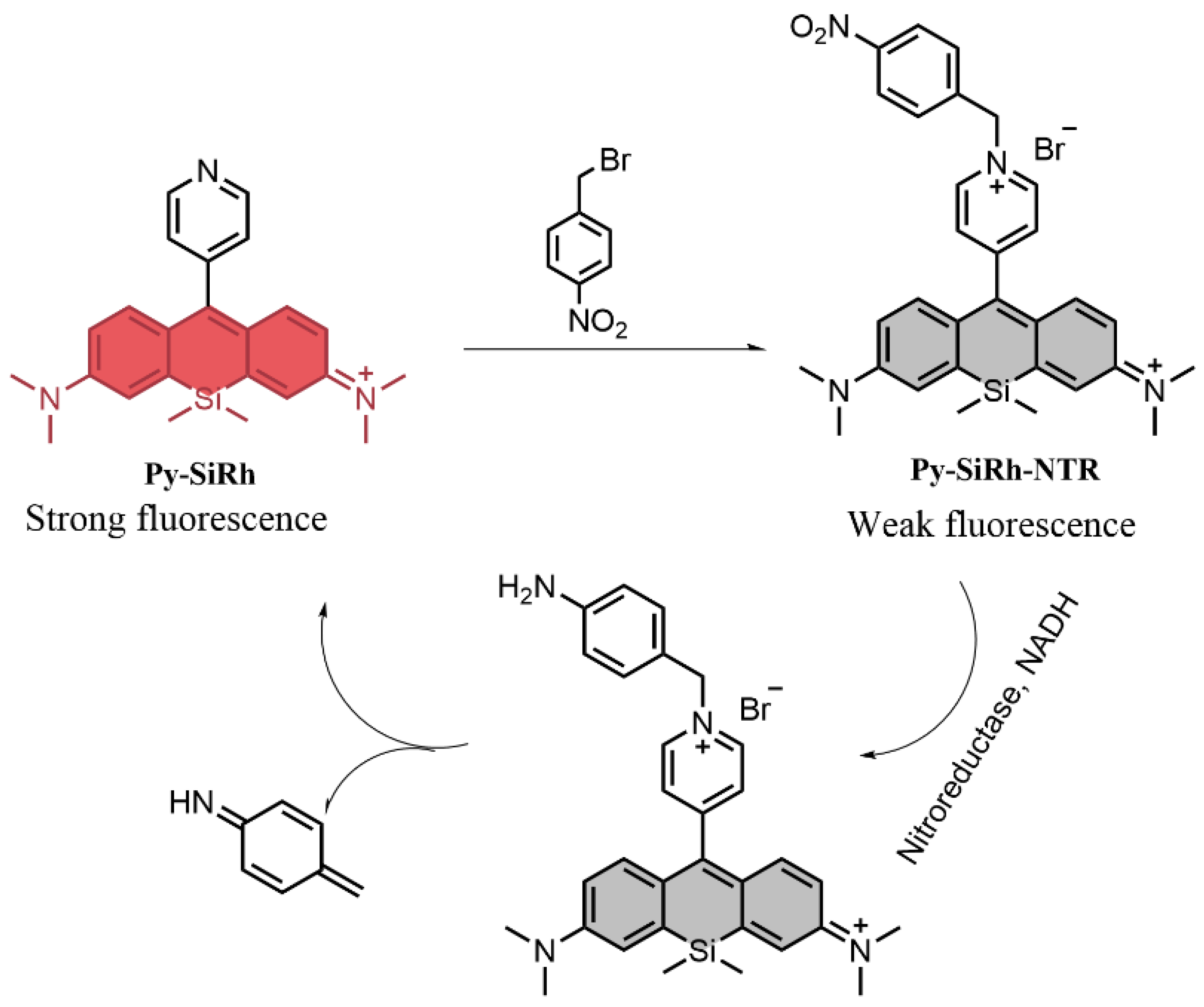
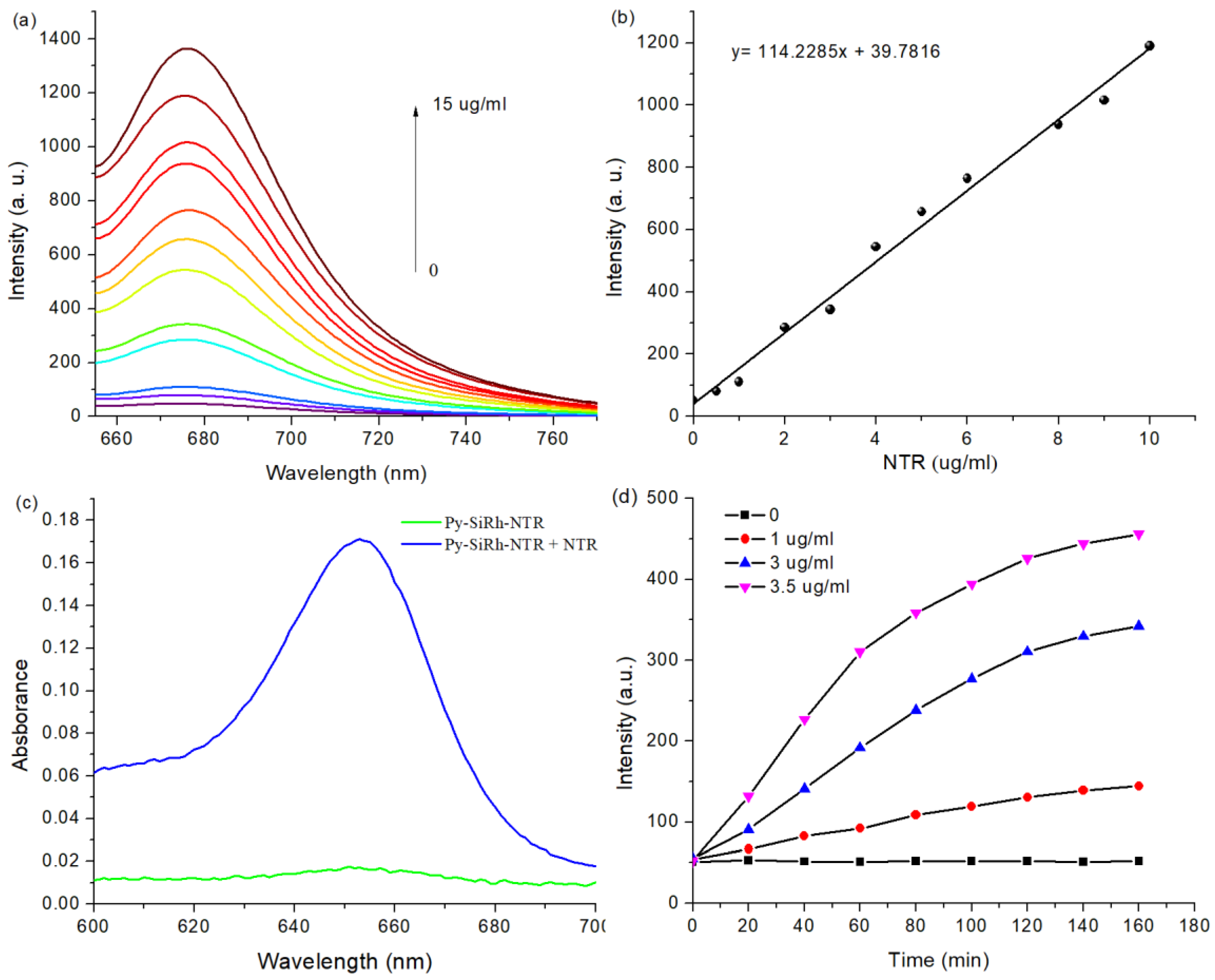
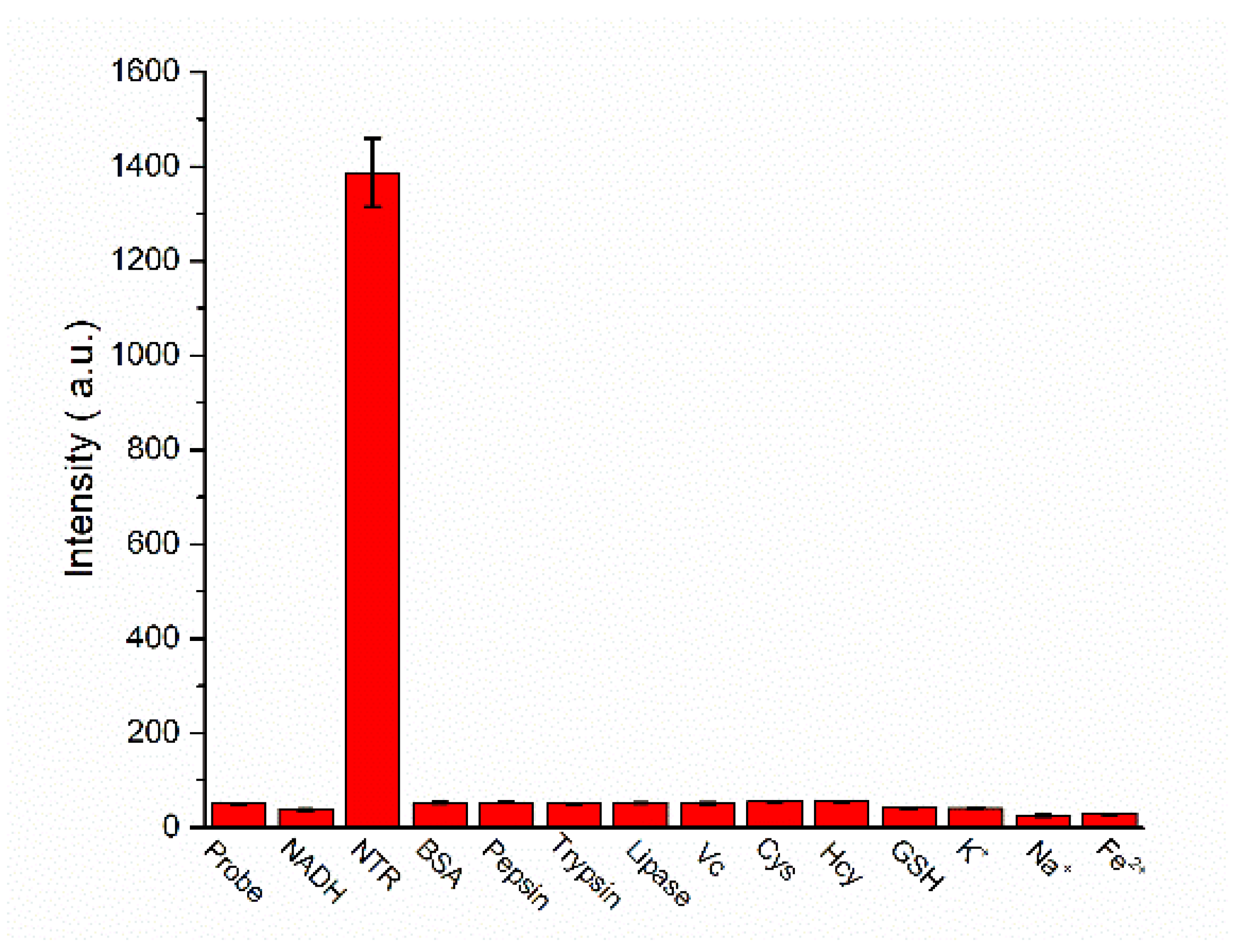

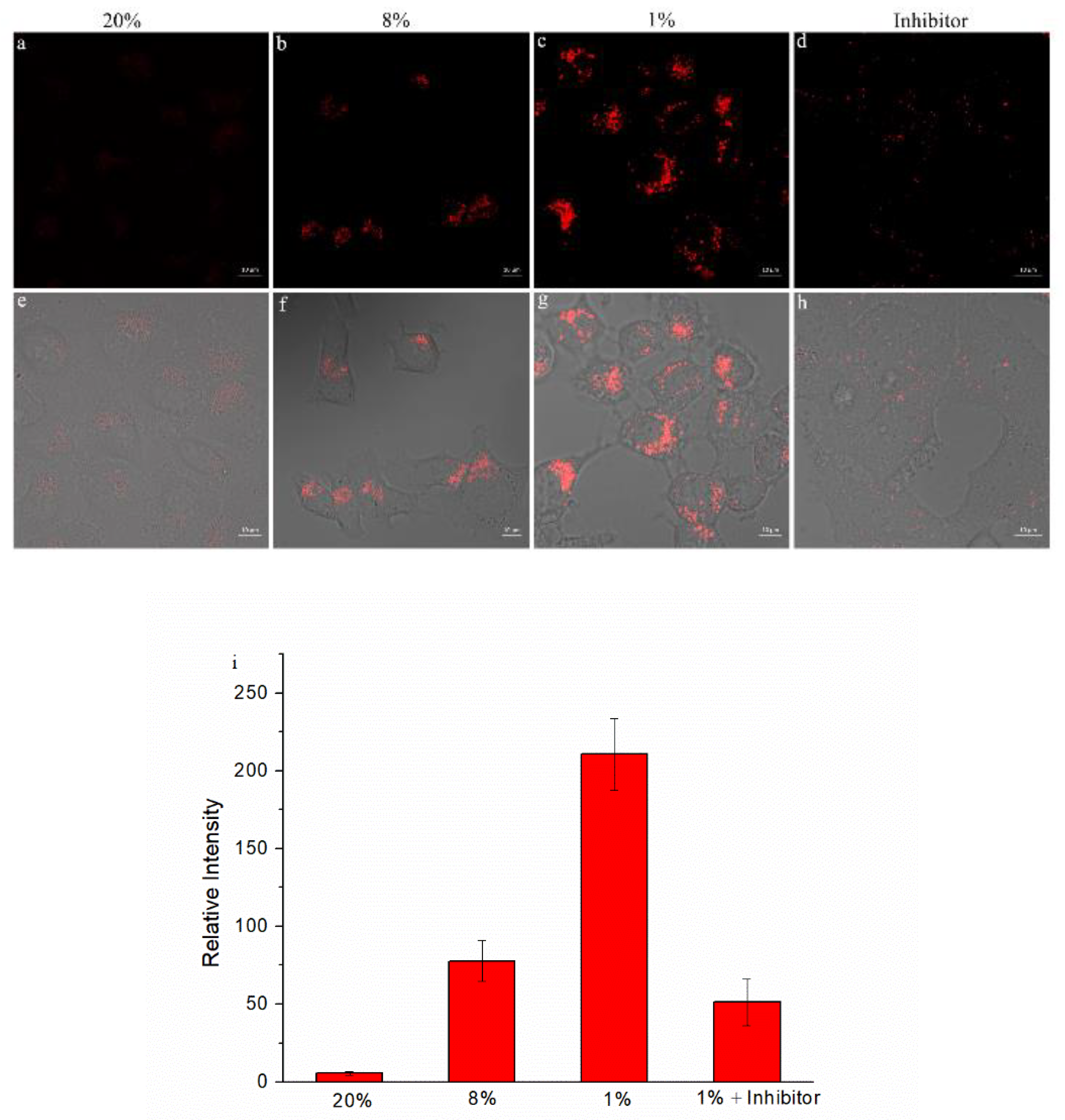
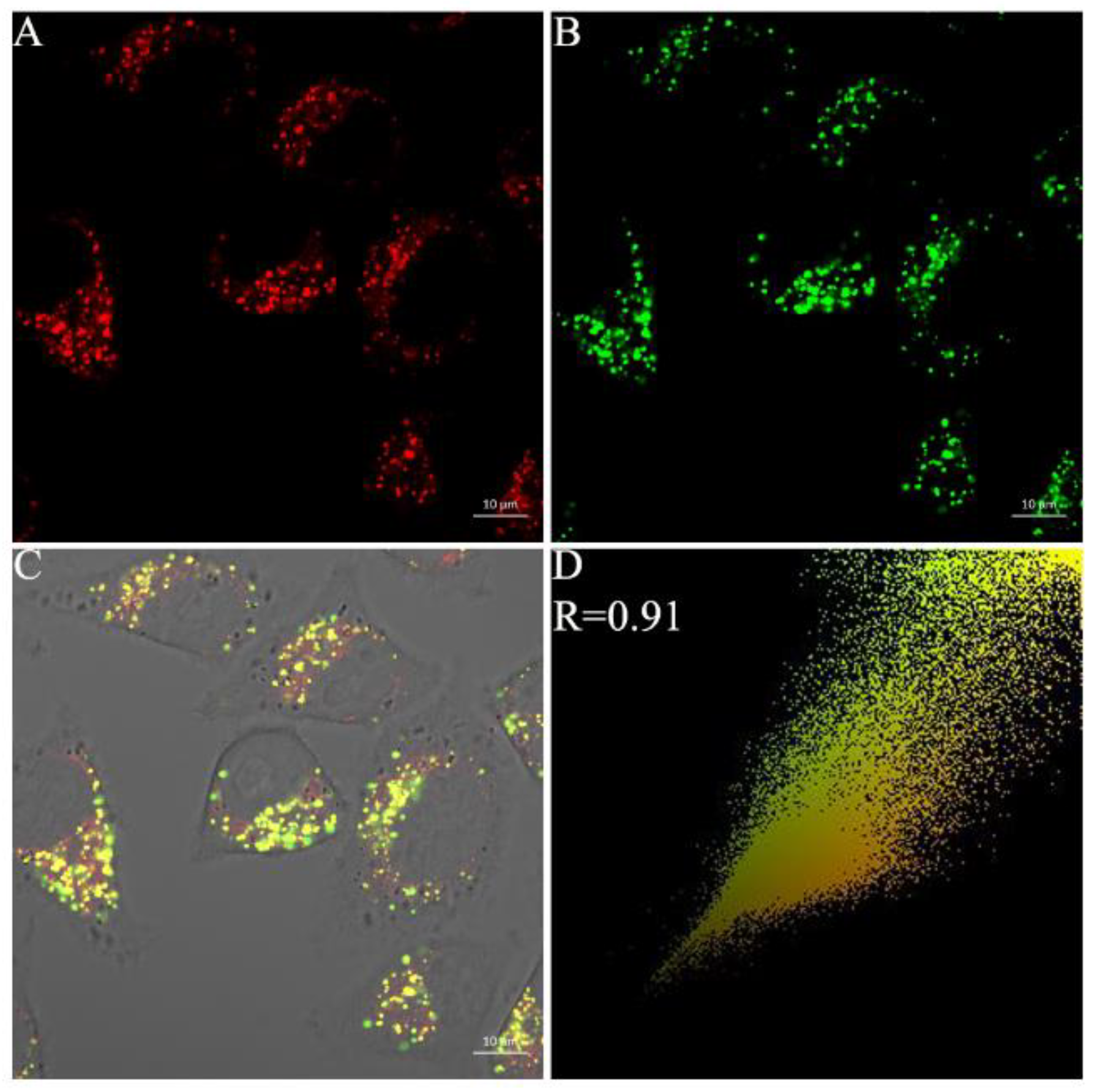
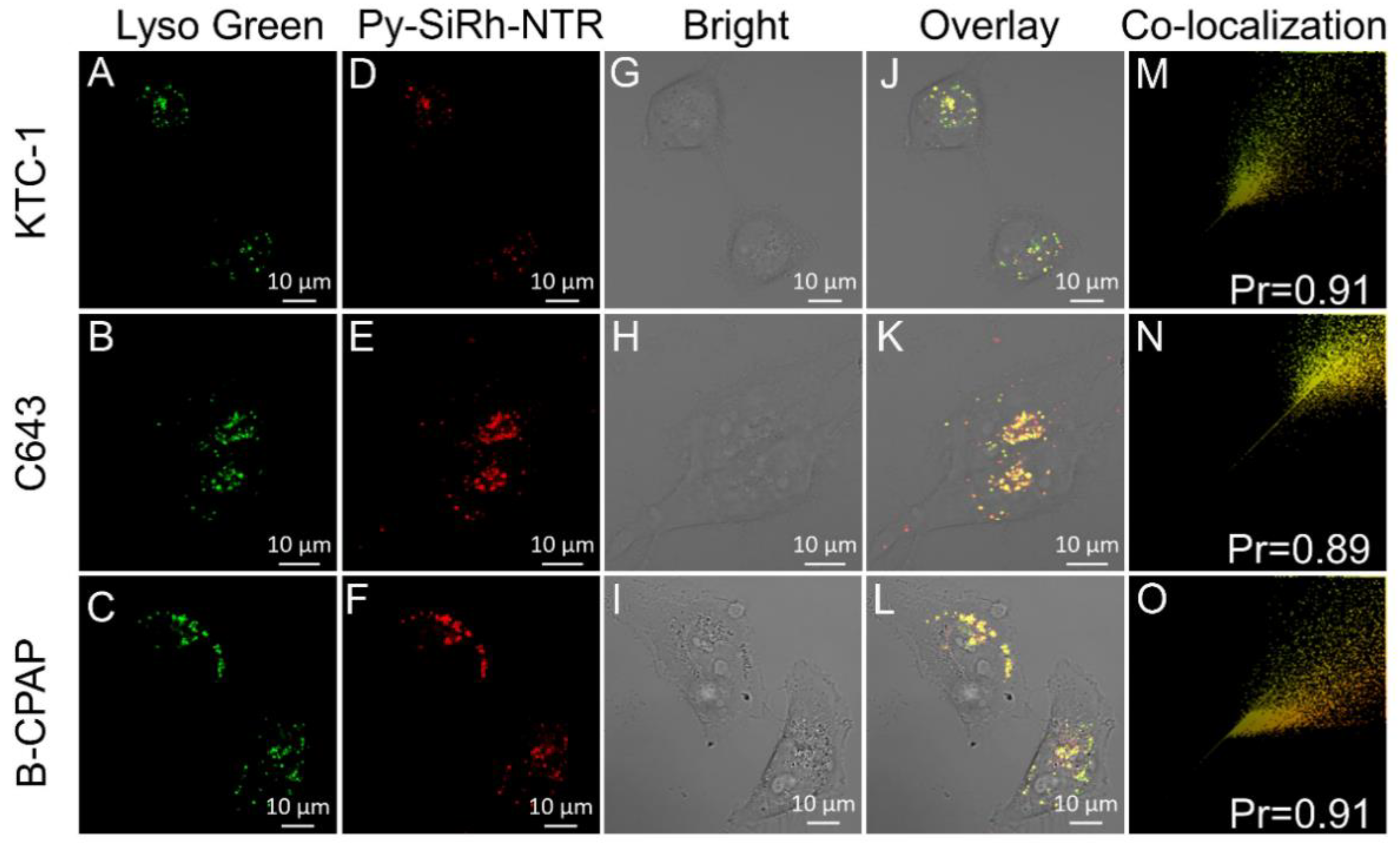
Publisher’s Note: MDPI stays neutral with regard to jurisdictional claims in published maps and institutional affiliations. |
© 2021 by the authors. Licensee MDPI, Basel, Switzerland. This article is an open access article distributed under the terms and conditions of the Creative Commons Attribution (CC BY) license (https://creativecommons.org/licenses/by/4.0/).
Share and Cite
Liu, F.; Zhang, H.; Li, K.; Xie, Y.; Li, Z. A Novel NIR Fluorescent Probe for Highly Selective Detection of Nitroreductase and Hypoxic-Tumor-Cell Imaging. Molecules 2021, 26, 4425. https://doi.org/10.3390/molecules26154425
Liu F, Zhang H, Li K, Xie Y, Li Z. A Novel NIR Fluorescent Probe for Highly Selective Detection of Nitroreductase and Hypoxic-Tumor-Cell Imaging. Molecules. 2021; 26(15):4425. https://doi.org/10.3390/molecules26154425
Chicago/Turabian StyleLiu, Feng, Hong Zhang, Kun Li, Yongmei Xie, and Zhihui Li. 2021. "A Novel NIR Fluorescent Probe for Highly Selective Detection of Nitroreductase and Hypoxic-Tumor-Cell Imaging" Molecules 26, no. 15: 4425. https://doi.org/10.3390/molecules26154425
APA StyleLiu, F., Zhang, H., Li, K., Xie, Y., & Li, Z. (2021). A Novel NIR Fluorescent Probe for Highly Selective Detection of Nitroreductase and Hypoxic-Tumor-Cell Imaging. Molecules, 26(15), 4425. https://doi.org/10.3390/molecules26154425




